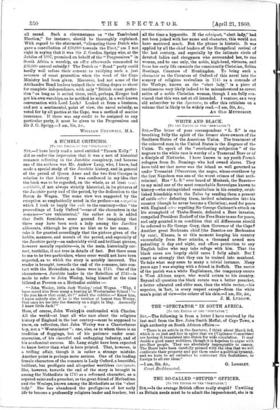A HUMBLE CRITICISM. [To THE CHLToit 0 , TILE " , ZPICTAT011."3
have lately read a novel entitled "Parson Kelly." I did so under the impression that it was a sort of historical romance referring to the Jacobite conspiracy, and because one of the authors was Mr. Andrew Lang, who, I knew, bad made a special study of the Jacobite history, and in general
of the period of Queen Anne and the two first Georges in relation to that history. I was confirmed in my idea that the book was to be regarded, on the whole, as at least 1,1vi- seml,/aldr, if not always strictly historical, in its pictures of
the Jacobite party and of the period, by the dedication to the Baron de Wogan. The same view was suggested by the exception so emphatically noted in the preface—an e,ecept ion
which I took to imply the rule to the contrary—that "the proceedings of Lady Oxford "—one of the characters in the romance—"are -unhistorical," the rather as it is added that Swift furnishes some ground for imagining that
there may have been such a lady among the Jacobite adherents, although he gives no hint as to her name. I take it for granted accordingly that the picture given of the habits, manners, and morals of the period, and especially of the Jacobite party—an undeniably vivid and brilliant picture, however morally repulsive—is, in the main, historically cor- rect, truthlike, if not true in details of fact. But there seem to me to be two particulars, where error would not have been expected, as to which the story is notably incorrect. The reader is brought, towards the end of the romance, into con- tact with the Methodists, as these were in 1745. One of the characters—a Jacobite leader in the Rebellion of 1745—is made to refer to John Wesley, being himself at the time billeted at Preston on a Methodist cobbler :— "'John Wesley, little Jack Wesley,' cried Wog,an. 'Why, I have saved him from many a beating at Westminster School !
Do you know that saint, sir?' asked the cobbler.—' Know him, I know nobody else, if he is the brother of honest Sam Wesley, that once let me into the deanery on a night in May. Assuredly I knew little Jack.'"
Here, of course, John Wesleyl is confounded with Charles. All the world—at least all who care about the religious history of England in the last century—must be supposed to know, on reflection, that John Wesley was a Charterhouse boy, not a " Westminster "; one, also, as to whom there is no tradition of floggings, but of his patience under semi- starvation, of his cheerful and unflagging industry, and of his academical success. Mr. Lang might have been expected to know better than what is here printed. That, however, is a trifling affair, though it is rather a strange mistake. Another point is perhaps more serious. One of the leading female characters of the romance is Lady Oxford, a beautiful, brilliant, but profligate and altogether worthless intrigante. She, however, towards the end of the story is brought in among the Methodists in 1745 as a reformed character, as a reputed saint and a preacher, as the great friend of Methodism and the Wesleys, known among the Methodists as the "elect lady." She has abandoned the prolligacies of her early life to become a professedly religions leader and teacher, but all the time a hypocrite. If the sobriquet," elect lady," had not been joined with her name and character, this would not have mattered much. But the phrase is historic. It was applied by all the chief leaders of the Evangelical revival of the last century, and especially by the intimate circle of devoted ladies and clergymen who surrounded her, to one woman, and to one only, the noble, high-bred, virtuous, and from her early life onwards the consistently Christian, Selina Hastings, Countess of Huntingdon. To bring such a character as the Countess of Oxford of this novel into the scenery of religious revivalism in 1745 as a comrade of the Wesleys, known as the "elect lady," is a piece of carelessness very likely indeed to be misunderstood as covert satire of a noble Christian woman, though I am fully con- vinced that this was not at all intended. I venture, as a very old subscriber to the Spectator, to offer this criticism on a volume that is likely to be widely read,—'I am, Sir, &c., AN OLD METHODIST.


































 Previous page
Previous page